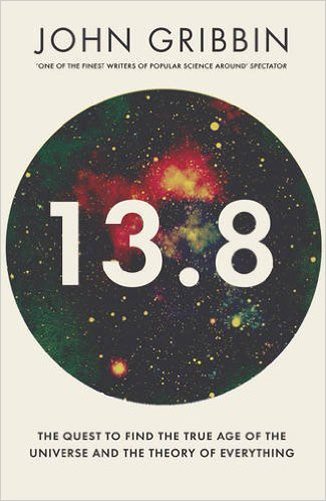 Two years ago, the Planck mission group at the European Space Agency produced a substantial data release that defined the best-ever measured age of the universe at 13.8 billion years. This was slightly older than previous best estimates. This important moment in defining one of the universe’s fundamental parameters caused John Gribbin, one of our premier science writers, to issue a new book.
Two years ago, the Planck mission group at the European Space Agency produced a substantial data release that defined the best-ever measured age of the universe at 13.8 billion years. This was slightly older than previous best estimates. This important moment in defining one of the universe’s fundamental parameters caused John Gribbin, one of our premier science writers, to issue a new book.
Gribbin’s 13.8: The Quest to Find the True Age of the Universe and the Theory of Everything, is a delight of high precision about a topic of high precision. The book (242 pp., hardcover, Yale University Press, New Haven, 2016, $30; ISBN 978–0–300–21827–5) is loaded with details about the story of the universe’s age and related matters.
The author begins by describing the modern starting point for understanding cosmology: the 1965 discovery of the cosmic microwave background radiation by Arno Penzias and Robert Wilson. The author organizes chapters with high-precision numbers, the first being 2.712, the temperature of the radiation in kelvins. Having established the fact that the universe had a definite beginning, Gribbin then proceeds to explore other detective stories of astrophysics and cosmology.
The quest to know the ages of stars follows, with the inner workings of the Sun, the creation of metals (elements heavier than hydrogen and helium), and the fundamental and difficult questions about the ages of the oldest stars all considered, with historical background and a grounding in astrophysical solutions.
About midway through the book, Gribbin turns toward the question that commenced the work, the age of the cosmos. Here the book really hits its stride in blending historical context, the methods of astrophysics, and backstories that allow readers to comprehend the difficulty facing astronomers decades ago who wished to take on such fundamental questions.
Along comes the discovery of universal expansion, the gritty period of the 1930s in which Einstein, Hoyle, and many others wrestled with cosmological theory, and the emergence of postwar cosmological models with an increasing air of sophistication.
By the time the book stares down the reader with a crescendo in mind, of satellites launched and high-precision measurements made, an entire short course in astrophysics has sunk into the minds of those who have dutifully followed along. The reason for the punch line, the incrementally increasing precision of measurements from surveys and satellites like Planck, crystallizes.
Not only will readers of this book understand how and why it took so long to nail down a clear look at the universe’s age, but they will also appreciate the amazing wonder we should have for finally knowing the answer to such a big question.
13.8 is a book that hits readers with unrelenting detail. And with a story as grand as this one, that’s exactly the way a good science book should have it. Nothing will be lost here, and everything — a clear understanding — will be gained.
Follow Dave Eicher on Twitter, and please check out his author page on Facebook.